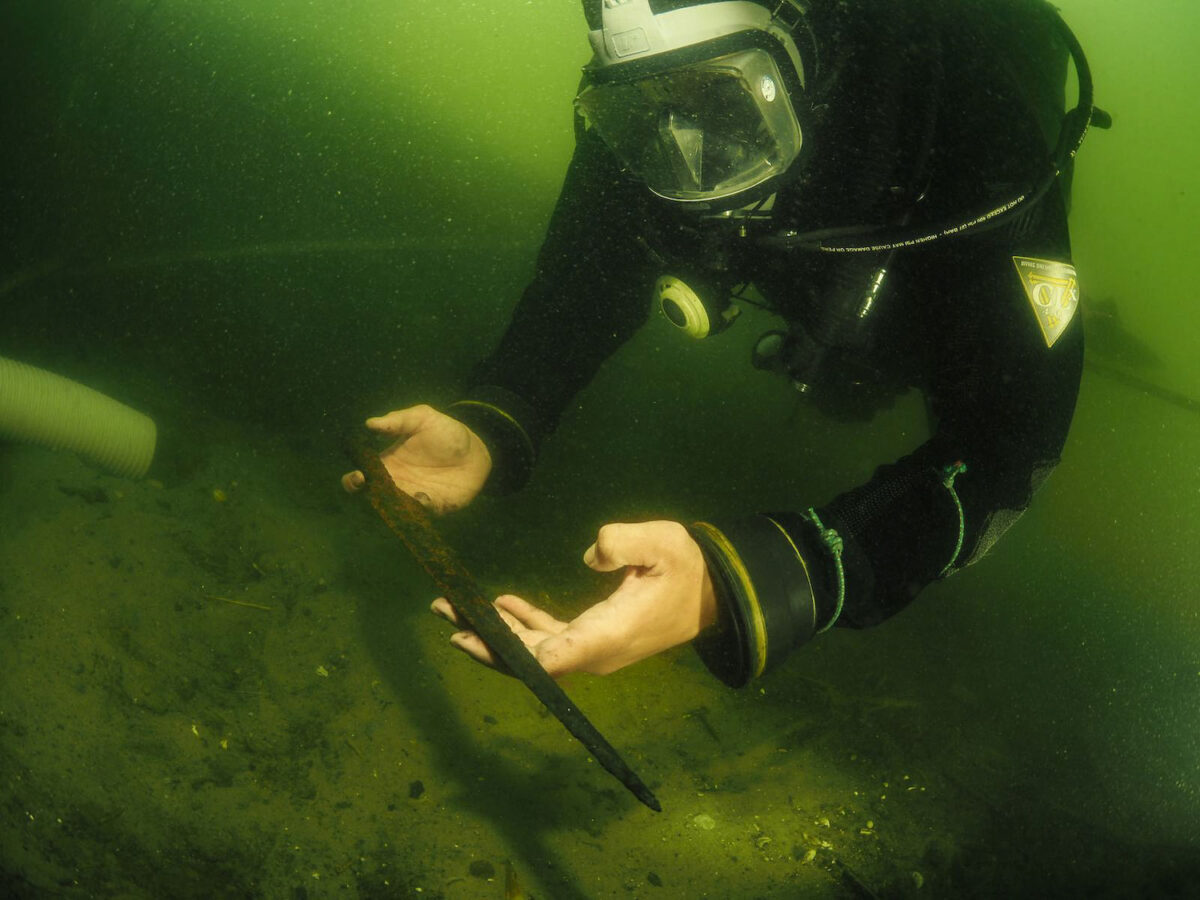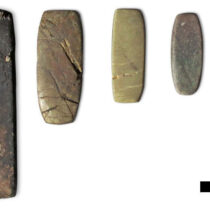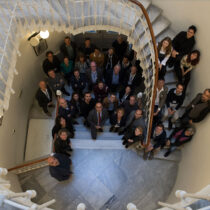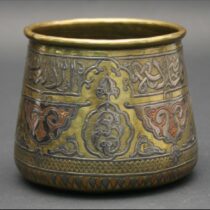Lake Lednica has been surprising archaeologists for decades. An impressive military collection from the times of Mieszko I and Bolesław Chrobry, numbering over 280 items, including 145 axes, 64 spearheads and 8 swords, has been recovered from its bottom. This year’s finds, although few in number, are unique in every respect. The newly discovered spears are preliminarily dated to the second half of the 10th and first half of the 11th century, a period when military and religious life flourished in the stronghold of Lednica under the first Piasts. Each of the four weapons tells a different story – from a simple warrior’s weapon to an elaborately decorated piece of craftsmanship that may have belonged to a magnate, or perhaps even the prince himself.
1. Spear with preserved shaft
The smallest of the spearheads, with a rhomboidal shape, has been preserved along with a fragment of an ash shaft approximately 2.1 metres long. This is a rarity – only two spears from Lake Lednica have such a well-preserved shaft. The weapon was finished with a ring made of antler, which makes it a unique artefact. Completely preserved spears are a rarity; two more are known from Lake Lednica, which were over three metres long. This year’s find confirms the information we know mainly from iconography, that both shorter and longer specimens were in use.
2. Willow leaf-shaped spear
The second spearhead, slender and delicate, resembles a willow leaf—a shape popular throughout Europe in the early Middle Ages. Although this form was common, similar specimens found within the Lednica complex may suggest local production and a strong craft tradition in the region.
3. Spear with a triangular leaf
The third spearhead, the longest of those found, has a triangular profile and was made using the technique of pattern welding – i.e., repeatedly welding soft, low-carbon steel with hard, high-carbon steel, which gave it better combat properties. It can be said that such spearheads represented the highest level of technology at the time, which was widely used throughout Europe.
4. The ‘ Duke’s’ spear
However, it was the last find that aroused the most excitement – a richly decorated spear with wings. The steel spearhead was placed on an intricately decorated sleeve. A significant part of the spear is covered with gold, silver, bronze and other metals, and its surface is decorated with intricate ornamentation featuring spiral and triskelion motifs. Chemical analyses have revealed the presence of as many as six metals: gold, silver, copper, tin, zinc and lead, as well as their alloys This was no ordinary weapon. The spear may have served as a symbol of power, the insignia of a warrior of high birth, or an object of a ritual nature.
Gold, silver and the mystery of the ornament
The decorations on the Lednice spear stand out from similar artefacts from across Europe. The sleeve and wings of the spearhead feature sharp braided motifs resembling claws or beaks. These are complemented by a dot ornament – rows of tiny dots filling in the braided motifs. Spearheads with decorated sleeves are unique examples of weaponry known from Northern and Eastern Europe. Three such specimens have already been discovered in the waters of Lake Lednica. However, there are no finds that are as rich. There is no doubt that the spear should be associated with the elite warrior culture of the 10th and 11th centuries. It is possible that the decorations served an identification function, allowing the owner of the weapon to be distinguished during ceremonies or battles, as well as demonstrating prestige and high social status. The presence of such a high-quality item on Ostrów Lednicki further emphasises the special significance of this centre, both politically and symbolically.
A scientific look into the metal
Every underwater discovery is just the beginning of the work. To uncover the secrets of the ‘duke’s spear, researchers from the Institute of Physics and the Interdisciplinary Centre for Modern Technologies at Nicolaus Copernicus University used modern X-ray macrofluorescence (MakroXRF) technology – a method that allows them to obtain a map of the distribution of chemical elements over a large area. During many hours of research, the X-ray beam moves point by point across the surface of the artefact, stimulating atoms to emit secondary X-rays characteristic of them (X-ray fluorescence). This creates a map of the distribution of elements, usually marked with different colours. Since X-rays penetrate beneath the surface of the object, the examination reveals not only what is visible to the naked eye, but also the original layers of decoration.
The maps obtained as a result of scanning clearly show:
-silver (Ag) on the sleeve – a remnant of silver plating,
-gold (Au) on the wings, which were originally gilded,
-copper (Cu) and zinc (Zn), indicating the use of brass,
-as well as lead (Pb), which may have been used to fill the decorations.
Such research not only allows us to decipher the ‘ formula’ of a medieval craftsman, but also to understand his working methods and recognise his sensitivity. Archaeologists hope that this research, as well as a detailed analysis of the ornamentation, will allow them to determine where the spear was produced – whether it was made in one of the local workshops associated with the stronghold on Ostrów Lednicki, or whether it was imported from more distant craft centres, perhaps Scandinavian or from the Rus. Determining its origin could provide new insights into the trade and political contacts of the early Piasts. Further specialist research in the field of dendrology and radiocarbon dating was also carried out. Analysis of the preserved fragments of the spear shafts allowed the species of wood used to be identified as ash, which was commonly used in the manufacture of spears in the early Middle Ages. Radiocarbon dating, carried out by Prof. Marek Krąpiec from the Absolute Dating Laboratory in Krakow, confirmed our assumptions about the chronology of the find, clearly placing it in the early Piast period.
Weapons in Lake Lednica – war or ritual?
Why were so many weapons found at the bottom of Lake Lednica? Scientists are considering two main hypotheses.
The first – military – links the finds to the dramatic events of the 1030s, when the Piast state was in crisis after the death of Mieszko II. According to reports, the Czech prince Břetislav invaded the country at that time, plundering Gniezno and most likely also the strongholds in Poznań and Ostrów Lednicki. Some of the weapons may have fallen into the water during the fighting for the stronghold, which took place both on the bridges connecting the island to the mainland and, most likely, on boats.
The second hypothesis – ritual – assumes that the weapons were deliberately placed in the water as an offering to the gods or spirits. Such practices have been known for centuries in many parts of Europe. Water was seen as a gateway to the world of the dead, and throwing a valuable object into it was a gesture of deep symbolic meaning.
Perhaps, then, the spears from Lake Lednica are not only evidence of ancient battles, but also traces of symbolic practices that may have survived despite the advancing Christianisation. The arsenal gathered at the bottom of the lake may echo both turbulent historical events and ancient beliefs about the power of water and the significance of sacrifice. Today, it is difficult to determine which of these hypotheses is closer to the truth – it is this uncertainty that keeps archaeologists returning to Lednica, as they continue to unravel the mysteries hidden beneath the lake’s surface. However, based on the analysis of military artefacts discovered in the depths of the lake, it can indeed be said that the craftsmanship of the workshops operating in the vicinity of Mieszko I and Bolesław Chrobry was on a par with that of Western European masters. Together with other artefacts from the reign of the first historical rulers of Poland, they testify to the cultural maturity and importance of the Piast state among the European elites of that time.
Cooperation and research are ongoing
The research conducted by the Centre for Underwater Archaeology at Nicolaus Copernicus University in Toruń in Lake Lednica is a continuation of many years of cooperation with the Museum of the First Piasts in Lednica. It is thanks to the combined experience of archaeologists, conservators and laboratory research specialists that it is possible not only to recover artefacts from the water, but also to reconstruct their history and original significance.
The 2025 season, which was supposed to be ‘‘calmer, turned out to be exceptionally fruitful. Archaeologists unanimously agreed that it was a really good season… a season for spears.
The discoveries from Lednica continue to surprise, and their analysis enables us to gain a deeper understanding of the world of the first Piasts – the people who laid the foundations of Polish statehood, culture, and craftsmanship.
Analysis of the shafts
The analysis of the shafts, or rather one completely preserved shaft and the remains of three others, made it possible to determine the type of wood from which they were made. It was ash, which is not surprising, as this material was commonly used in this type of weaponry in the early Middle Ages.
Absolute dating
The context of the finds leaves no doubt as to their chronology; however, we decided to conduct radiocarbon dating, which Prof. Marek Krąpiec performed from the Absolute Dating Laboratory in Krakow. The results confirmed our assumptions. Based on the belief that the samples from Lake Lednica are of the same age and using collective radiocarbon calibration, the most likely calendar chronology centres on the beginning of the 11th century CE.
The most probable chronology for the assumed uniform age of the samples from Lednica, resulting from collective calibration, is 1016–1030 cal AD, and the probability intervals are:
-68.3% (Dominant Mode) 1016 – 1030 cal AD 40.3%
-68.3% (Alternative Mode) 995–1005 AD 27.9%
For a wider 95.4% probability range, the collective chronology is 993–1032 AD. What does this mean for us? It seems certain that the spears ended up in the lake during the reign of Bolesław Chrobry.
Further research
The artefacts found, especially the richly decorated spearhead, deserve further research. In cooperation with AGH University of Science and Technology, we plan to perform X-ray (computed) tomography scanning used in metallurgical research. This will enable us to understand the internal structure of the objects and the technology used to produce them. This research will be conducted as part of the E-RIHS.pl consortium’s research infrastructure, coordinated by Nicolaus Copernicus University. Isotopic analyses of selected metals found on the “duke’s spear’ are also planned to determine the origin of these metals, which would allow the place of origin of this prestigious object to be established.
What next for the artefacts?
Spectacular artefacts mean spectacular conservation challenges. It has been decided that the spear will be secured by a team led by Prof. Piotr Niemcewicz from the Faculty of Fine Arts at Nicolaus Copernicus University, in close cooperation with the conservation workshop at the Museum of the First Piasts in Lednica, led by Łukasz Broński. After conservation, the spearheads will be on display at the Museum of the First Piasts in Lednica.
From weapon to symbol – the heritage of Lednica
The spears from Lake Lednica are now more than just iron artefacts. They tell the story of Poland’s beginnings, of power, faith, art, and technology, which came together on one island.
Thanks to underwater research, we can look into the past not through the prism of chronicles, but through authentic objects that were held in the hands of rulers, warriors and craftsmen a thousand years ago. Water – a silent witness to history – has preserved them for centuries. Now, thanks to modern science, they are regaining their voice, and the general public will be able to see them at an exhibition at the Museum of the First Piasts in Lednica. More than 40 years of underwater archaeological research show one thing: Lednica has not yet had its final say.





